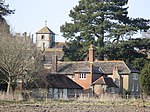Chanctonbury Hill
Sites of Special Scientific Interest in West Sussex

Chanctonbury Hill is an 82.7-hectare (204-acre) biological Site of Special Scientific Interest west of Steyning in West Sussex. Part of it is Chanctonbury Ring, an early Iron Age hillfort which contains two Romano-Celtic temples and which is a Scheduled Monument.This site on the steep slope of the South Downs is mainly woodland with some areas of chalk grassland. A dew pond has great crested newts, a species protected under the Wildlife and Countryside Act 1981. More than sixty species of breeding birds have been recorded, including meadow pipits, corn buntings and green woodpeckers.
Excerpt from the Wikipedia article Chanctonbury Hill (License: CC BY-SA 3.0, Authors, Images).Chanctonbury Hill
Wiston Bostal,
Geographical coordinates (GPS) Address Nearby Places Show on map
Geographical coordinates (GPS)
| Latitude | Longitude |
|---|---|
| N 50.895 ° | E -0.38 ° |
Address
Wiston Bostal
BN44 3DP
England, United Kingdom
Open on Google Maps










